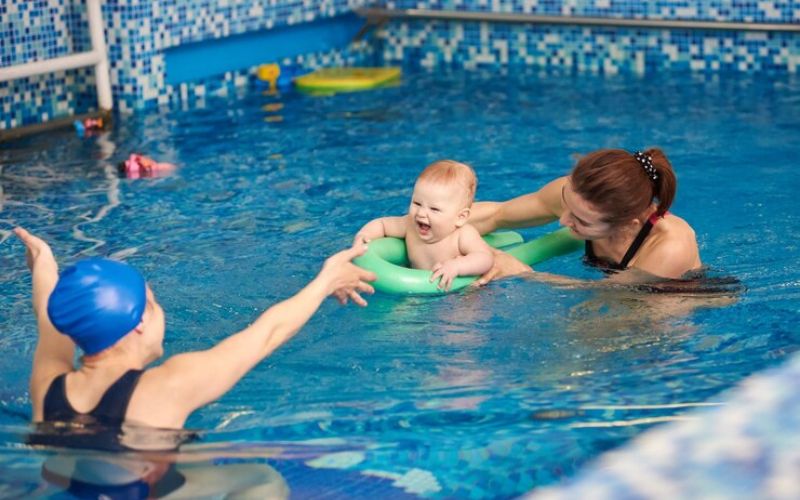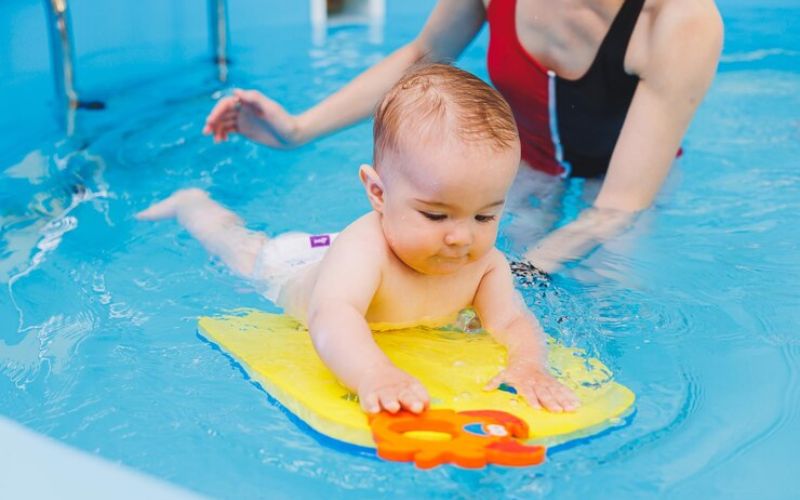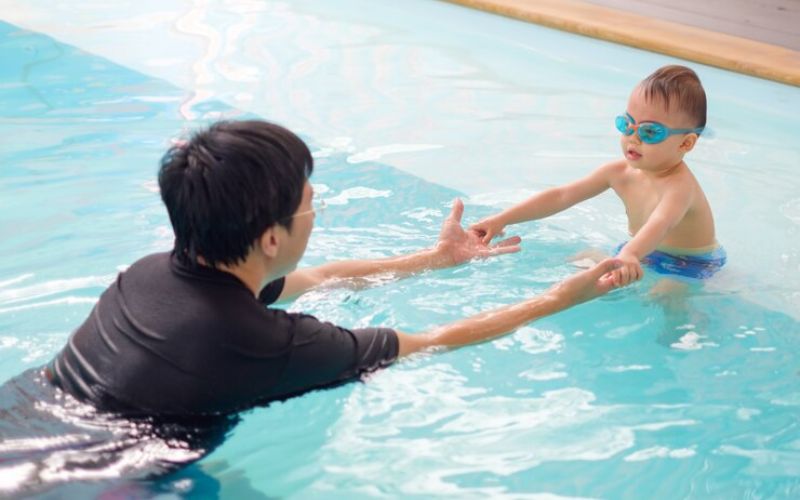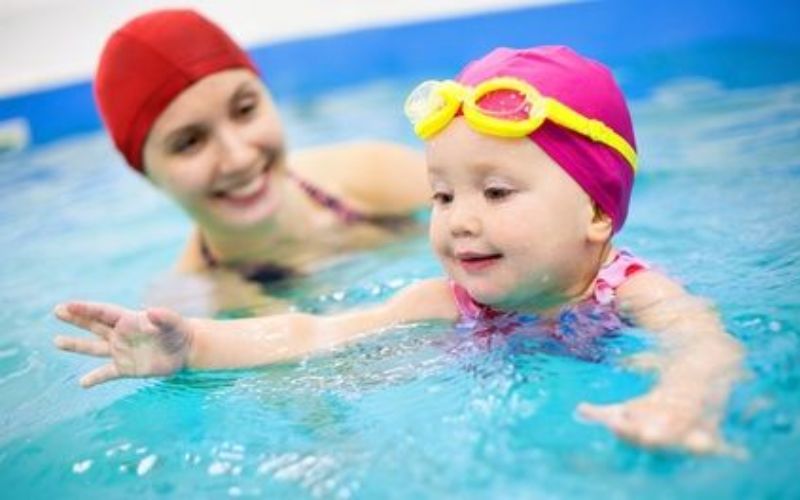Last Updated on October 31, 2023 by Muhammad Sohaib
Swimming is a life skill that not only promotes physical fitness but also offers countless moments of joy and adventure.
Teaching a child to swim is a rewarding experience that can instill confidence, foster a love for water, and, most importantly, enhance their safety around water bodies.
In this article, we will guide you through the process of teaching a kid to swim.
Benefits of Early Swimming Lessons
Starting early with swimming lessons offers several advantages. Kids tend to be more receptive to new experiences at a young age.
Early exposure to water can build confidence and make them comfortable in aquatic environments.
Preparing for the First Swim

Choosing the Right Swim Gear
Before you dive into swimming lessons, ensure you have the right gear. This includes
- swimsuits
- Goggles
- and flotation devices appropriate for your child’s age and skill level.
Finding a Suitable Swim Environment
Select a safe and controlled environment for your child’s first swim. This could be a
- home pool
- A community pool, or
- A swim center with experienced instructors.
Setting Realistic Expectations
Every child learns at their own pace. Don’t push your child too hard or expect immediate results. Be patient and adapt to their comfort level.
Building Water Confidence
Fun Water Play at Home
Foster an early love for water by incorporating fun water activities at home. Bath time can be an opportunity for them to play and become familiar with water.
Gradual Exposure to Water
Take small steps to introduce your child to water. Start with wading in shallow areas, and gradually progress to deeper sections as their comfort level increases.
Encouraging a Positive Attitude
Maintain a positive and encouraging demeanor. Avoid displaying your fears or anxieties about water, as children often mirror their parents’ emotions.
Finding the Right Instructor
Qualities to Look for in a Swim Instructor
If you decide to enlist the help of a swim instructor, look for someone who is patient, experienced in teaching children, and certified in CPR and water safety.
Red Cross and Other Certification Programs
Many instructors and swim schools follow Red Cross or similar certification programs, ensuring a standardized and safe approach to swimming lessons.
Learning Basic Techniques

Teaching Kids to Float
Floating is one of the fundamental skills in swimming. Start by teaching your child to float on their back, which is a crucial survival skill.
The Importance of Breath Control
Teach your child how to control their breath while in the water. Proper breathing is essential for buoyancy and maintaining composure.
Introduction to Basic Strokes
Begin with basic strokes like the doggy paddle or freestyle. As your child progresses, introduce other strokes like the breaststroke and backstroke.
Safety First
Understanding Water Safety Rules
Teach your child the essential water safety rules, such as not running by the pool, not diving in shallow water, and not swimming alone.
Monitoring Your Child in the Water
Keep a watchful eye on your child while they’re in the water, even if there is a lifeguard present. Constant supervision is vital.
Teaching Kids to Identify Hazards
Educate your child about potential hazards in and around water, such as strong currents, underwater obstacles, and slippery surfaces.
Overcoming Fear and Anxiety
Addressing Common Swimming Fears
It’s normal for children to have fears when it comes to swimming. Some may be afraid of the water, while others may fear the unknown.
Acknowledge these fears and discuss them with your child to alleviate their concerns.
Building Trust and Providing Reassurance
Reassure your child that you’ll be there to support and guide them throughout the learning process. Building trust is essential for their comfort in the water.
Gradual Progression in Lessons
Take small steps to gradually build your child’s confidence. Start with activities they enjoy, like playing with water toys, and slowly incorporate more structured lessons.
Practice Makes Perfect

The Importance of Regular Practice
Consistency is key when teaching a child to swim. Regular practice helps reinforce their skills and boosts their confidence in the water.
Fun Water Games and Activities
Make learning to swim enjoyable by incorporating games and activities. These can include races, underwater treasure hunts, or even just splashing around.
Encouraging Peer Interaction
If possible, arrange for your child to swim with friends or other kids their age. Peer interaction can make swimming more fun and less intimidating.
Keeping It Fun
Incorporating Play into Lessons
Incorporate playfulness into your swimming lessons. Use colorful pool toys, play water games, and make each session an exciting adventure.
Using Toys and Props
To make lessons engaging, use toys and props that float, sink, or glide through the water. These aids can make learning more interactive.
Celebrating Achievements
Celebrate small and big achievements. Whether it’s swimming a few meters or floating independently, praise your child’s efforts to boost their confidence.
Dealing with Challenges
Handling Setbacks and Fears
It’s normal for children to face setbacks and fears during their swimming journey. Be patient and understanding, and provide the support they need to overcome these challenges.
Recognizing Individual Learning Styles
Every child learns differently. Pay attention to your child’s unique learning style and adapt your teaching methods to suit their needs.
Seeking Professional Advice When Needed
If your child faces significant difficulties in learning to swim or exhibits intense fears, consider seeking advice from a pediatric swim therapist or counselor.
Graduating to Advanced Levels
Moving from Beginner to Intermediate
As your child gains confidence and skill, consider enrolling them in more advanced swim lessons to further enhance their abilities.
Specialized Swim Programs
Explore specialized programs such as synchronized swimming, water polo, or diving, which can be both fun and rewarding.
Competitive Swimming Opportunities
If your child develops a strong passion for swimming, they may have opportunities to compete in local or school swim teams.
Swimming Safety Tips

Constant Supervision
Always maintain vigilant supervision when your child is in or around water. Accidents can happen in seconds.
Appropriate Swim Gear
Ensure your child wears appropriate swim gear, including life jackets if needed, and that it fits well.
Avoiding Crowded or Unsafe Areas
Select swim areas that are safe, clean, and well-maintained. Avoid crowded pools or areas with strong currents.
Preparing for Emergencies
CPR and First Aid Knowledge
It’s crucial for parents to have basic CPR and first aid knowledge in case of emergencies.
Creating an Emergency Action Plan
Discuss and rehearse an emergency action plan with your child. Teach them how to call for help and what to do in various water-related emergencies.
Staying Calm Under Pressure
In stressful situations, staying calm and collected is vital. Reassure your child and follow your emergency plan.
Conclusion
In conclusion, teaching a child to swim is an essential life skill that can save lives and open up a world of aquatic enjoyment.
By following these steps and being patient and supportive, you can guide your child to become a confident and skilled swimmer.






